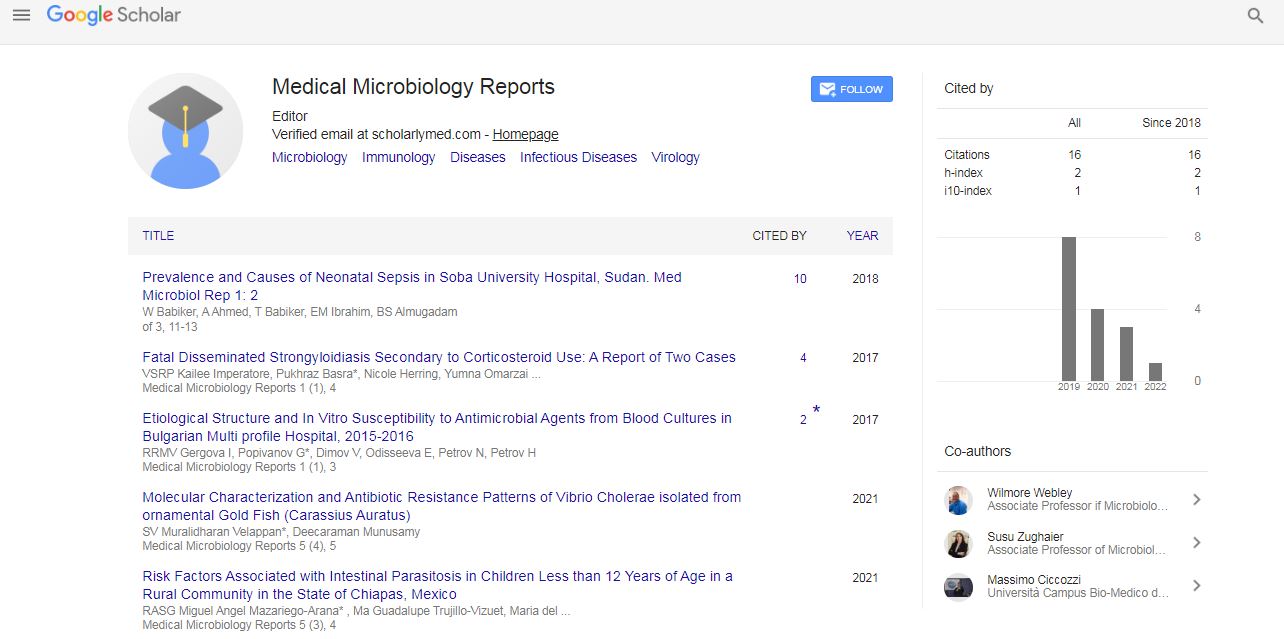Perspective, Med Microbiol Rep Vol: 6 Issue: 2
Microbial Infection of Consuming Water and Human Fitness
Eric Carle*
Department of Microbiology, Immunology and Infectious Diseases, Cumming School of Medicine, University of Calgary, Calgary, AB, Canada
*Corresponding Author:Eric Carle
Department of Microbiology, Immunology and Infectious Diseases, Cumming School of Medicine, University of Calgary, Calgary, AB, Canada
Email: carlec99@yahoo.com
Received date: 01 March, 2022, Manuscript No. MMR-22-59650;
Editor assigned date: 04 March, 2022; Pre QC No. MMR-22-59650 (PQ);
Reviewed date: 14 March, 2022, QC No. MMR-22-59650;
Revised date: 23 March, 2022, Manuscript No: MMR-22-59650 (R);
Published date: 30 March, 2022, DOI: 10.4172/mmr.1000315.
Citation: Carle E (2022) Microbial Infection of Consuming Water and Human Fitness. Med Microbiol Rep 6:2.
Keywords: Microbial Infection
Description
The relations of microorganism to the activities of the phytoplankton and zooplankton, and to the general chemical and biotic situations happening in sparkling water, are nevertheless to be as it should be determined. Results received via preceding employees, mainly in Europe and the United States, at the distribution of bacteria in lakes have no longer been absolutely in settlement. A number of the discrepancies had been due to the truth that very few ordinary and systematic series of bacterial counts have been made over a protracted length; variations in forms of lakes and strategies of approach had been contributory reasons. One of the earliest studies became made by Kleiber (1894) who studied the destiny of bacteria washed into Lake Zurich by way of inflowing rivers. He concluded that the sector, rich in microorganism, did no longer make bigger into the lake lots farther than 20 m. from the mouth of the rivers. Pfenniger (1902) discovered that the distribution of bacteria in Lake Zurich become typically uniform except for sure periodic fluctuations. Most bacterial numbers came about in the course of the iciness and minimal numbers in summer season, similar to the intervals of stream and stratification of the water. Pfenniger's paintings was to some extent confirmed by means of Minder (1920) who also found better numbers of microorganism in wintry weather than in summer season. Minder, but, acquired plenty decrease numbers in samples taken from the immediately surface of the lake, at some point of the summer season, than in samples taken at depths only some metres decrease. In fashionable the number of microorganism increased with intensity. He claimed that the quantity and depth of sunlight had been directly chargeable for the fluctuations in numbers of bacteria, such fluctuations being a result of multiplication of the autochthonous kinds and no longer of the showering in of soil bacteria. The quantity and variant of nutritive materials inside the water had no direct impact on the bacterial populace. In a later paper (1927), however, averages of bacterial counts in Lake Zurich over a length of 12 years are given which display lowering numbers in samples from unique depths inside the following order: 15 m, 5 m, 0 m, 30 m and 50 m.
Methods
A few difficulties became encountered at first in finding a suitable tool for taking samples on the one-of-a-kind depths, without infection from upper layers for the duration of the elevating of the sample. Previous people have, in fashionable, used evacuated vials which had been lowered to the required position; the neck of the vial turned into then damaged by means of a messenger falling down the cable. Because the making of the severe vials required considerable time and the quantity of water obtained was too small, a new tool became invented through Dr C. H. Mortimer. Briefly, the equipment includes a sterile eleven. Winchester bottle clamped right into a stand and so arranged that a falling messenger operates a trip which releases a spring and causes a unique fitting at the mouth of the bottle to be removed to permit the access of water. Assessments proved that blending with surface water throughout elevating did no longer take vicinity and the equipment labored effectively at all the depths at which it changed into employed. Details of the equipment are given within the subsequent paper. The numbers of the microorganism had been decided in all samples of water.
Thermal Stratification in Lakes
Earlier than offering the outcomes at the distribution of bacteria it's far crucial to remember the physical situations which occur in lakes, in view of the probable impact of those situations at the microorganism. At some point of the overdue spring and early summer season the temperature of the surface water of a lake rises owing to multiplied solar radiation and the resulting difference in density of the water gives upward push to the formation of awesome layers of water, the upper layer or " epilimnion " and the lower layer or "hypolimnion". Beneath a few situations the temperature is approximately the equal in any respect depths inside the epilimnion; below this stratum, in the transitional zone known as the "thermocline", the temperature falls unexpectedly with growing depth, and inside the hypolimnion, the temperature, which is extensively decrease than that of the epilimnion, does not change notably with increasing intensity.
Horizontal Distribution Microorganism
Collection of samples at an intensity of 1 m. had been amassed in Windermere, at various distances from the mouth of the in flowing river Brathay. Consequences of examination of those samples are proven in desk. From the observations made on 22 July 1938 and a pair of November 1939, its miles glaring that there may be a rapid and widespread lower within the variety of feasible bacteria whilst the river meets the lake. On the primary event there was no substantial decrease among the point of entry and a distance of 133 m. However numbers fell nearly to 1-1/3 between 133 m and 536 m. No huge decrease becomes acquired over a similarly 221 m. On 2 November 1939, the bacterial remember reduced to 1-30th at a point 191 m. from the point of entry. From this factor to 4180 m. there was no tremendous change. The 0.33 set of samples turned into taken with a purpose to discover whether or not any variant in numbers passed off at widely separated factors in deep open water. Between points 2800 and 6000 m. From the River Brathay no vast lower took place.
 Spanish
Spanish  Chinese
Chinese  Russian
Russian  German
German  French
French  Japanese
Japanese  Portuguese
Portuguese  Hindi
Hindi 
